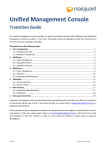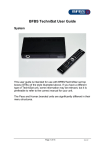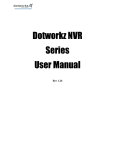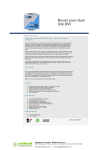Download TELALASKA NETWORK MANAGEMENT POLICY
Transcript
TELALASKA NETWORK MANAGEMENT POLICY In this document, the terms “you” and “your" refer to customers of TelAlaska’s Internet Access Service. The terms “we” and “our” refer to TelAlaska and TelAlaska’s Internet Access Service. Definitions Service – Internet access purchased from TelAlaska. This includes connectivity from your equipment at your premises to the Internet equipment at TelAlaska’s office, connection of TelAlaska’s equipment to the Internet, and TelAlaska’s equipment that is used to route and manage your traffic to and from the Internet and to provide you with services such as e-mail, web surfing, file transfer, Internet video, and others. Bandwidth – The amount of data per second. This may be thought of as the “pipe” that carries Internet traffic. Bandwidth capacity is the amount of bandwidth that we or another network provider makes available for your use, such as the amount of data that can be sent over a wire or fiber optic system. Bandwidth demand is the amount of bandwidth that a customer wants to use. Congestion – A situation where the total bandwidth demand (in bits of information per second) on a component of the Internet, including on any part of our network, exceeds the bandwidth capacity of that component to such an extent that traffic flow and service experiences degradation. Congestion is usually of a transitory nature, however, in some cases, such as an extremely popular website, it may last for a significant period. Degradation of Service - Less than optimal performance of Internet services. This may appear to you as slow response on web sites and e-mail or distorted or frozen video. Nominal Bandwidth – The bandwidth of the service package you purchase. This is your maximum allowed bandwidth. Terms of Service and Network Management Practices The bandwidth you purchase (your service package or nominal bandwidth) is the MAXIMUM bandwidth available to you. Unless you have purchased a Dedicated Bandwidth service that specifically guarantees a fixed bandwidth, such as a T-1 circuit, it is not a guaranteed bandwidth. TelAlaska will make its best effort to transmit your data in a timely fashion, however, TelAlaska does not guarantee you that you will be able to use your entire nominal bandwidth at any given time. This is referred to as “best effort” service. TelAlaska strives to make your total nominal bandwidth available for you to use within our network. TelAlaska cannot control bandwidth available, congestion, or service quality on those parts of the Internet beyond our network. When other customers use our network, you may not be able to use your maximum nominal bandwidth because all customers share total bandwidth capacity at some points on our network and on the Internet. If the bandwidth demand of all customers at that network location exceeds the bandwidth capacity provided, you may not be able to use your entire nominal bandwidth. All services other than Dedicated Bandwidth services are “shared services” used by many customers. We size our Internet services by the bandwidth of all our customers, including your service, based on best-of-breed engineering practices. Service is provided equally to all customers, and every customer's data has an equal chance to be served. Page 1 of 4 TELALASKA NETWORK MANAGEMENT POLICY TelAlaska may block any service, protocol, source, or destination that TelAlaska determines to be illegal or a threat to life, property, or national security, or if ordered to block or otherwise modify your data by law enforcement agencies, TelAlaska is committed to providing the best online experience possible for all of its customers. The company uses reasonable network management practices that are consistent with industry standards. TelAlaska manages its network with one goal: to deliver the best possible terrestrial and satellite based broadband Internet experience to all of its customers. High-speed bandwidth and network resources are not unlimited. Managing the network is essential to promote the use and enjoyment of the Internet by all of our customers. We use reasonable network management practices that are consistent with industry standards. We also try to use tools and technologies that are minimally intrusive. Just as the Internet continues to change and evolve, so too, will our network management practices to address the challenges and threats on the Internet. All Internet service providers need to manage their networks. If TelAlaska didn't manage our network, our customers would be subject to the negative effects of spam, viruses, security attacks, network congestion, and other risks and degradations of the service. By engaging in reasonable and responsible network management, TelAlaska Inc. can deliver the best possible terrestrial and satellite based broadband Internet experience to all of its customers. TelAlaska uses various tools and techniques to manage its network, deliver its service, and ensure compliance with the TelAlaska Networks Acceptable Use Policy These tools and techniques are dynamic, like the network and its usage, can and do change frequently. For example, these network management activities may include identifying spam and preventing its delivery to customer email accounts, detecting malicious Internet traffic and preventing the distribution of viruses or other harmful code or content and using other tools and techniques that TelAlaska may be required to implement in order to meet its goal of delivering the best possible broadband Internet experience to all of its customers. We will provide updates here and in other appropriate locations if we make important or significant changes to our network management techniques. The current congestion management technique works as follows: If a certain area of the network nears a state of congestion, the technique will ensure that all customers have a fair share of access to the network. It will identify which customer accounts are using the greatest amounts of bandwidth and their Internet traffic will be temporarily managed (up to 72 hours). Customers will still be able to do anything they want to online, but they could experience things like: longer times to download or upload files, surfing the Web may seem somewhat slower or playing games online may seem somewhat sluggish. The technique does not manage congestion based on the online activities, protocols or applications a customer uses; it only focuses on the heaviest weekly users, to mitigate the periods of congestion. It is important to note that the effect of this technique is temporary and it has nothing to do with a customer’s aggregate monthly data usage. Rather, it is dynamic and based on prevailing network conditions as well as a customer’s data usage over a very recent period of time. The technique is "protocol-agnostic," which means that the system does not manage congestion based on the applications being used by customers. It is also content neutral, so it does not depend on the type of content that is generating traffic congestion. Said another way, customer traffic is congestionPage 2 of 4 TELALASKA NETWORK MANAGEMENT POLICY managed not based on the applications or content being used, but based on current network conditions and recent amounts of data transferred by users. With this technique, most customers will notice no change in their Internet experience. The goal of congestion management is to enable all users to have access to a fair share of the network at peak times, when congestion occasionally occurs. Congestion management focuses on the consumption activity of individual customer accounts that are using a disproportionate amount of bandwidth. As a result, and based on our experience with this technique, we have determined that the large majority of customers are not affected by it. In fact, based on our experience, we find that on average less than one percent of our High-Speed Internet customers are affected by the approach. Our experience also shows that when our systems apply the congestion management technique to an individual user’s account, it is usually only in effect for a very brief period of time. Based on our operational experience, TelAlaska has determined that congestion management is required 24 hours a day to ensure the best possible Internet customer experience. TelAlaska monitors how user traffic is affected by our policies and will make the adjustments reasonably necessary to ensure that our Internet customers have a high-quality online experience. TelAlaska also routinely evaluates its overall network performance and periodically enhances its network by adding capacity to address congestion and other performance issues. TelAlaska will not implement network management if degradation of service is caused by congestion on portions of the Internet outside of TelAlaska’s network. Devices & Software that may be Attached to TelAlaska’s Internet Access Service There are no restrictions on types of devices you may connect to TelAlaska’s network other than that they must be approved by the Federal Communications Commission (FCC) for use in the US telecommunications network. You may not connect any equipment to TelAlaska’s network that is not approved by the FCC. Most commercially available equipment such as modems, routers, and PCs are approved. All equipment approved by the FCC will have a label stating that it is approved and what the type of the approval is. This information is also found in the user’s manual or printed instructions that are provided with the equipment and may be found online at the manufacturer’s website. You should read this label whenever you buy any equipment you wish to connect to TelAlaska’s network. TelAlaska’s Internet access service is designed to function with accepted industry standard interface software such as provided by Microsoft, Apple, and others. If you use a type of software not widely used in the worldwide Internet, you may experience some problems with compatibility between your software and TelAlaska’s Internet access service. It is the customer's responsibility to assure that their software and operating interfaces conform to industry accepted specifications. Network Security TelAlaska uses the latest industry-best-practices to maintain integrity and security of its network. This may include security protections that interfere with some types of customer traffic. TelAlaska provides a level of protection for your computers from spam, viruses, and other malicious or unwanted items. While TelAlaska strives to provide the best protection possible for your computer, we make no guarantees that we can prevent all malicious or unwanted items from accessing your computer. It is the customer’s responsibility to protect their computers and other devices from unwanted or harmful items. It is very strongly recommended that you provide your own virus and Page 3 of 4 TELALASKA NETWORK MANAGEMENT POLICY malware protection, spam filtering, and firewall software, solutions are available on the TelAlaska website. There are additional considerations regarding Internet security related to TelAlaska’s Internet access service. See our TelAlaska Networks Acceptable Use Policy. Services TelAlaska Offers Detailed information on TelAlaska Internet access services and pricing in your community may be found at http://www.telalaska.com The bandwidths listed are the maximum bandwidth of the service. You will not be provided additional bandwidth above what you purchased, even for short periods of time. You are not permitted to “burst” traffic above your purchased bandwidth. Use of TelAlaska’s Services for Real-Time Applications such as Streaming Video The Best Effort internet access service offerings above may be suitable for real-time applications if the customer has purchased adequate bandwidth for that service. Disruption during times of congestion, if any, which you experience will be minimized if you purchase adequate bandwidth for the services you wish to use. However, since there are occasionally conditions of extreme congestion at various points in the Internet, including TelAlaska’s network, unless you have purchased a Dedicated Bandwidth service that specifically guarantees a fixed bandwidth, such as a T-1 circuit, TelAlaska does not guarantee that your service will never be degraded. Note that bandwidth requirements will differ by real-time application. For example, video such as that offered by various services such as YouTube may require somewhat less total bandwidth than entertainment quality streaming video. Bandwidth requirements may also differ among providers. Privacy of Customer Information TelAlaska inspects packets of data you send or receive over our network to allow us to route and, where applicable, prioritize data. We inspect only the packet headers which tell us where to send your data and the type of data it is, i.e.: web surf, video, file transfer, etc. TelAlaska does not examine the content of your data, i.e.: the data which you send or receive, such as the messages from and to e-mail addresses of your e-mail, which web sites you visit, the sources of your video, or the contents of files you send or receive. TelAlaska does not store your data, or sell or reveal it to any third parties. TelAlaska may provide any of your data, both on an active, real time basis and stored data such as your billing records, to law enforcement under appropriate legal orders if law enforcement requests your information in matters dealing with illegal acts or a threat to life, property, or national security. Contact Us If you have questions or comments regarding our network management policies or practices, please contact TelAlaska NetWorks customer service. In Anchorage at 907-563-2116, Outside of Anchorage at 888-478-3127 and outside Alaska at 907-5632060 or [email protected]. Technical support can be contacted at 888-570-1792 or [email protected] or visit our Technical Support Site. Page 4 of 4











